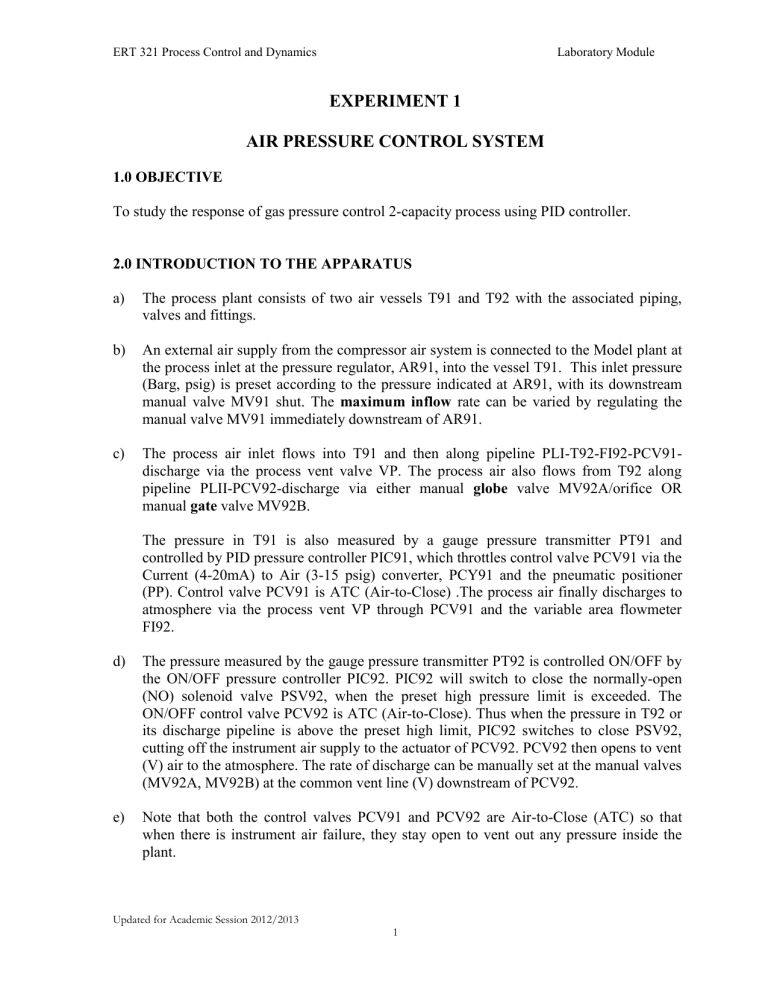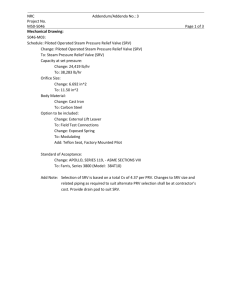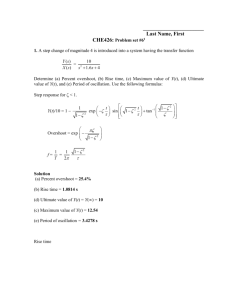Air Pressure Control System

ERT 321 Process Control and Dynamics Laboratory Module
EXPERIMENT 1
AIR PRESSURE CONTROL SYSTEM
1.0
OBJECTIVE
To study the response of gas pressure control 2-capacity process using PID controller.
2.0
INTRODUCTION TO THE APPARATUS a) The process plant consists of two air vessels T91 and T92 with the associated piping, valves and fittings. b) An external air supply from the compressor air system is connected to the Model plant at the process inlet at the pressure regulator, AR91, into the vessel T91. This inlet pressure
(Barg, psig) is preset according to the pressure indicated at AR91, with its downstream manual valve MV91 shut. The maximum inflow rate can be varied by regulating the manual valve MV91 immediately downstream of AR91. c) The process air inlet flows into T91 and then along pipeline PLI-T92-FI92-PCV91discharge via the process vent valve VP. The process air also flows from T92 along pipeline PLII-PCV92-discharge via either manual globe valve MV92A/orifice OR manual gate valve MV92B.
The pressure in T91 is also measured by a gauge pressure transmitter PT91 and controlled by PID pressure controller PIC91, which throttles control valve PCV91 via the
Current (4-20mA) to Air (3-15 psig) converter, PCY91 and the pneumatic positioner
(PP). Control valve PCV91 is ATC (Air-to-Close) .The process air finally discharges to atmosphere via the process vent VP through PCV91 and the variable area flowmeter
FI92. d) The pressure measured by the gauge pressure transmitter PT92 is controlled ON/OFF by the ON/OFF pressure controller PIC92. PIC92 will switch to close the normally-open
(NO) solenoid valve PSV92, when the preset high pressure limit is exceeded. The
ON/OFF control valve PCV92 is ATC (Air-to-Close). Thus when the pressure in T92 or its discharge pipeline is above the preset high limit, PIC92 switches to close PSV92, cutting off the instrument air supply to the actuator of PCV92. PCV92 then opens to vent
(V) air to the atmosphere. The rate of discharge can be manually set at the manual valves
(MV92A, MV92B) at the common vent line (V) downstream of PCV92. e) Note that both the control valves PCV91 and PCV92 are Air-to-Close (ATC) so that when there is instrument air failure, they stay open to vent out any pressure inside the plant.
Updated for Academic Session 2012/2013
1
ERT 321 Process Control and Dynamics Laboratory Module
CONTROL SYSTEM AND INSTRUMENTATION
PT91 : Gauge Pressure Transmitter. Calibrated Range: 0-25 psig
Measures air pressure in T91
PCV91
PP
: Pressure control valve ½”. Air-to-Close (ATC).
Regulated by PID controller PIC91 or PIC92
: Pneumatic Positioner, with By-pass.
PCY91
PSV92
PCV92
: Current-to-Air Converter (I/P) : 4-20mA to 3-15 psig
: Solenoid valve, Normally-Open (NO)
: ON/OFF pneumatic control valve, Air-to-Close (ATC).
PCV92 is opened by ON/OFF controller PIC92 via PSV92, when the pressure measured by PT91 is above its preset high pressure limit.
PG91, PG92, PG93, PG94 : Pressure Gauges
TG91, TG92
FI92
PRV91, PRV92
SV91
: Temperature Gauges
: Variable area flowmeter (Rotameter). Metal construction safety type.
: Pressure Relief Valves
: ON/OFF Solenoid Valve
The Annunciators are:
PAD91 : The pressure at T91, measured by PT91, exceeds its preset Deviation from the setpoint, whether above or below. The Deviation alarm limit is set at DL1 at the “PID1” page or panel.
PAL91 : The pressure at T91, measured by PT91, drops below its preset Low alarm limit. The Low alarm limit is set at PL1 at the “PID1” page or panel.
Updated for Academic Session 2012/2013
2
ERT 321 Process Control and Dynamics Laboratory Module
3.0
EXPERIMENTAL PROCEDURE
1. Make sure the Instrument Air Supply (IAS) or AR91 is set at 26-28 psig. Adjust the manual valve MV91 till rotameter FI92 is at flowrate of 30Nm³/Hr max.
DO NOT exceed the stated flowrate.
2. Check the pressure with PCV91 fully shut. The parameter PV1 at controller PIC91
(i.e. PT91) should be 22-27 psig. Reset AR91 if the pressure is insufficient.
3. Check the flowrate with PCV91 fully open. The parameter PV1 at controller PIC91
(i.e. PT91) should be less than 5-6 psig and the flowrate at FI92 is not more than the recommended flowrate. Readjust MV91 for maximum flowrate.
4. Make sure the valve Positioner (PP) at PC91 is ON and connected. With PIC91 in
Manual (M) mode, stroke the control valve PCV91 manually with MV = 100%, 50% and 0% and note that the corresponding valve stem position at its stem indicator scale is 0%, 50% and 100% opened.
5. With PIC91 in the Manual (M) mode, open the control valve PCV91 fully with
MV= -6.3%. For confirmation, check the control valve stem position at PCV91.
Take note of the minimum pressure PV1 (in PIC91). Concentrate on the Pressure PID panel controller PIC91/PIC92 and the recorder PR91.
6. Check that vessels T91 and T92 are connected for air to flow in series from one vessel to the next. Check their respective pressure at the pressure gauges PG91 and PG92.
The manual By-pass valve B92 around T92 should be fully shut. The final manual discharge valve (VP) downstream of the pressure control valve PCV91 should be fully opened.
7. Start the recorder PR91 by pressing the ‘RCD’ pushbutton at the front of the recorder with its swing front cover opened. Note that PT91 response is shown by the Red pen
(Channel 1), Input Range: % of 0-25 psig. The recorder chart drive is preset for ‘fast speed’ (500mm/Hr).
8. Access the PID values in the pressure PID controller PIC91, at the PID1 page or panel. Set the following first (I) trial PID values.
PB1 = 70 %, TI1 = 40 secs, TD1 = 0
9. Adjust the setpoint SV to 18 psig (72%) at PIC91. Make sure the chart drive of the recorder PR91 is running. Otherwise, press the “RCD” button at the front of the recorder with its swing front cover opened.
10. Transfer PIC91 to Auto (A) mode and watch the response at the recorder PR91 till it is steady at its setpoint SV to within ± 0.1 psig or continues to oscillate even after 3 cycles.
Updated for Academic Session 2012/2013
3
ERT 321 Process Control and Dynamics Laboratory Module
11. Continue the experiment for both 2-capacity and 1-capacity processes using the following settings:
70/40/0
PIC91 PID Pressure Control of T91/92
PID
Values
Setpoint, psig
Same PID, different SV.
70/40/0
70/40/0
Different PID, same SV.
20/30/0
45/30/0
Fine tune Second (II) PID, increasing PB1 by 10% and reducing TI1 by 10 secs at a time.
18
18-9
15
15
15
Test
Load step test
Setpoint step test
Load step test
Load step test
Load step test
Load step test
12. Apply the load step test as follows:
When the response is steady, switch PIC91 to Manual (M) mode and decrease its MV by 5-10%. Quickly switch PIC91 back to Auto (A) and observe the pressure response at the recorder PR91 till it is almost steady to within ± 0.1 psi, or continue to show oscillatory response even after 3 cycles. The chart recording constitutes the results of your experiment. Note down on the chart the PB1, TI1, TD1 and SV values. Watch closely for overdamped and underdamped response and the possibility of any inlet load disturbance. Careful consideration must be taken then to provide effective control.
13. Apply the setpoint step test as follows:
With PIC91 in Auto (A) mode, apply a step change in setpoint (SV) from 18 to 9 psig
(72% to 36%). Observe the chart response similarly and note down the SV and PID1 values on the chart.
14. In order to check for process inlet load disturbance, carefully monitor the response. If the response tends to oscillate outside the desired control band of ±0.1 psig (i.e. below
8.9 and above 9.1 psig for SV = 9 psig; OR below 17.9 and above 18.1 psig for SV = 18 psig); switch PIC91 to Manual (M) mode and observe if the pressure i.e. process air inlet supply is still oscillating.
Note: Oscillation of process air inlet supply is a load disturbance at the process inlet.
Updated for Academic Session 2012/2013
4
ERT 321 Process Control and Dynamics Laboratory Module
15. If the load disturbance does occur, then the PID values ( 70% / 40 sec/ 0 sec ) may have slowed down the controller action, till it is slower than the process inlet disturbance.
Thus, try a faster TI i.e. set TI1 = 10 to 20 secs instead of 40 secs, for faster setpoint recovery. Observe similarly for any improvement.
16. To shut-down AP922:
- Shut MV91 but do not adjust AR91.
Switch PIC91 to Manual (M) mode with its MV = 0%
Shut fully the isolation manual valve at the main air supply line to Model AP922.
4.0 RESULTS/DISCUSSION
Relevant portions of the recorder chart responses should be submitted as results of the experiment, with the following pertinent data marked on the corresponding chart recording:-
Setpoint (SV), PB%, TI seconds, TD seconds.
NOTE:
The Recorder chart speed is occasionally printed on the chart, for example at
500 mm or 0.139 mm or 7.2 secs
Hr sec mm
Provide your results and discussion by answering the following questions: a) Study and compare the different pressure responses for different PID values.
Calculate the time constant and dead time for each response. b) Use the following terms to calculate the dynamics of underdamped process:
Rise time, Settling time, Overshoot and Period of oscillation. c) What is the purpose of testing the PID at different setpoint? d) In your opinion, is PID a good controller for gas pressure control? State your reason(s).
Updated for Academic Session 2012/2013
5





